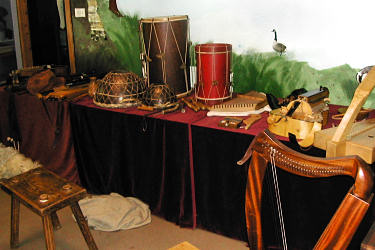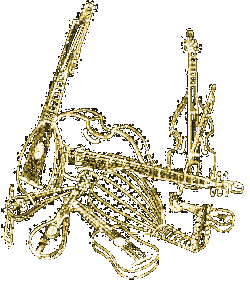Music
Musical Instruments of the 17th Century

The Renaissance is one of the most exciting periods of musical history. In many senses it is where music as we know it today began, and without the many innovations introduced during this period modern culture would be radically different.
Below is a selection of musical instruments that would have been used during the Baroque era:

-
The Cornetto
was one of the greatest virtuoso instruments of the 16th and early 17th centuries. It is classed as a brass instrument because of the mouthpiece, which is like that of the trumpet. However, unlike the trumpet, the cornetto (or cornet) has no valves. Notes are made by altering the shape of the lips around the mouthpiece. -
The Recorder
has been a popular instrument from medieval times up to the present day. Blowing through the mouthpiece and covering the holes create the sound and the different notes. There are many different sizes of recorder that each make different pitched sounds; the smallest being only a few centimeters long, and the longest being as tall as a person! -
The Lute
is a stringed instrument. It is played much like a guitar, however it has more strings (as many as fifteen). It was most popular during the Stuart times, and originates from Arabic countries, but European versions of this instrument appeared from the 13th century. -
The Violin
is part of the string family and was a very popular instrument in the 17th century. It has four strings, which can be plucked or bowed. Placing the fingers on the strings on the neck of the violin makes different notes. -
The Viol
was a predecessor of the violin but was still a popular instrument. As with the violin, it is a stringed instrument, and played in the same way. It was larger than the violin and had six strings instead of four. -
The Harpsichord
is also a member of the string family. It is an early form of piano and a very popular instrument. -
The Flute
is a member of the wind family. It is played by blowing across the hole in the mouthpiece, and covering the holes on the fingerboard with your fingers to create different notes. The 17th century version had a stronger, lower range than earlier flutes, and had the ability to play louder and softer to provide a better tone to perform the new solo music being composed during the 1600s. -
The Trumpet
in the 17th century was very different to modern day trumpets. The most notable difference is that there are no valves, slides or pistons on the 17th century version (known as the natural trumpet). It had a restricted range, limited to the high notes due to the lack of valves and was difficult to play as it placed high demands on the player's lips.
Curriculum links:
- MUSIC: Explore song as a news medium and propaganda tool. Discover why the Renaissance is one of the most exciting periods of musical history, and learn about rhythm and the different instruments used during this period.

